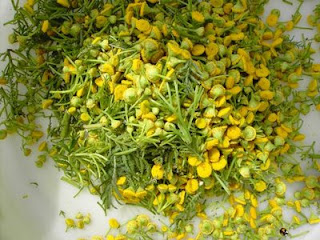Summer is supposed to be a quiet time. Good to go on a holiday. But not here. Everywhere I see colour growing in my garden. Especially Tansy and Goldenrod are in full bloom. So it was time to heat up the dyepot again.

De bloemschermen van het boerenwormkruid werden zoveel mogelijk ontdaan van ongedierte (vooral luis en oorwormen) en geknipt, tot ik ongeveer 800 gram had, wat genoeg moest zijn voor 200 gram wol. De wol was gebeitst met 15% aluin.
The tops of the tansy were cut and shaken, to free them from beasts, that shouldn't be there. I collected about 800 grams, enough to dye 200 grams of wool. The wool had been premordanted with 15% alum.
 Het kruid moest (veel) fijner geknipt worden. Gelukkig kwam Wendy langs, en die heeft ook even helpen knippen.
Het kruid moest (veel) fijner geknipt worden. Gelukkig kwam Wendy langs, en die heeft ook even helpen knippen.
The Tansy had to be cut up, to be much smaller pieces. Fortunately Wendy came by and helped cutting. Na een uurtje trekken in heet water, kon de wol erbij en zowaar, na een uurtje: er was weer kleur in gekomen. Omdat ik gelezen had, dat het soms een mooi resultaat gaf, wanneer de wol in een ammoniakoplossing gedoopt werd na het verven, had ik wat ammoniak in een emmer water klaar staan. Toen was het net toveren: de wol werd aanzienlijk donkerder door deze behandeling!
Na een uurtje trekken in heet water, kon de wol erbij en zowaar, na een uurtje: er was weer kleur in gekomen. Omdat ik gelezen had, dat het soms een mooi resultaat gaf, wanneer de wol in een ammoniakoplossing gedoopt werd na het verven, had ik wat ammoniak in een emmer water klaar staan. Toen was het net toveren: de wol werd aanzienlijk donkerder door deze behandeling!
Er was nog zoveel kleur in het verfbad, dus ik voegde een restje blauwhoutoplossing toe, dat er trouwens wat bedorven uitzag (het stond ook al heel lang) en deed er wat voorgebeitste, ongesponnen wol in. Dit liet ik na het verven de hele nacht in het bad afkoelen. De kleur was duidelijk anders en nog verbazingwekkend sterk.
De volgende dag knipte ik guldenroede op dezelfde manier. Omdat ik u wel genoeg gele wol had, voegde ik wat cochenille toe. Die had ik eerst voorgeweekt met warm water en een druppeltje afwasmiddel. De wol was een gekabelde Wensleydale, die ik niet mooi vond na het spinnen. Goed voor experimenten als deze, dus. Hier zijn de resultaten:
The plants soaked in hot water for about an hour, and then I added the wool. After another hour it really was coloured nicely. Because I read somewhere that an afterdip in a pot with an ammonia solution gives a nice effect, I made such a solution and tried it with two of my skeins. It was like magic! The colour got so much deeper!
Because much colour was still left in the dyebath I added some campeche dye (left over from another dyeing session, but very old and not looking very promising) and some unspun premordanted wool. After dyeing I left it to cool in the dyebath all night, and was surprised by the result. It was really different from the others.
The next day I cut goldenrod and treated it in the same way. But because I felt I'd enough yellow for a while, I added some (a teaspoonful) cochenille, which soaked in hot water and a drop of dishwashing liquid for a while first. The wool I dyed here was a cabled Wensleydale, which I didn't like so much after spinning it. Good for using in experiments like these. here are the results:
 Vlnr: guldenroede met cochenille, boerenwormkruid, boerenwormkruid met ammoniak, gekamde wol met boerenwormkruid/blauwhout en de ongekamde versie hiervan.
Vlnr: guldenroede met cochenille, boerenwormkruid, boerenwormkruid met ammoniak, gekamde wol met boerenwormkruid/blauwhout en de ongekamde versie hiervan.
From left to right: goldenrod with cochenille, tansy, tansy with ammoniadip, combed wool with tansy/campeche and the uncombed version of that.
 Tenslotte nog een foto van mijn nieuwste breiproduct: de sjaal Casablanca, gevorderd tot en met de derde aanwijzing: De Marokkaanse torentjes, hier op de kop te zien. Vooral de verhalen die de ontwerpster erbij vertelt en waarmee ze aangeeft hoe ze tot haar ontwerp gekomen is, vind ik boeiend. Haar inspiratiebron was de film Casablanca.
Tenslotte nog een foto van mijn nieuwste breiproduct: de sjaal Casablanca, gevorderd tot en met de derde aanwijzing: De Marokkaanse torentjes, hier op de kop te zien. Vooral de verhalen die de ontwerpster erbij vertelt en waarmee ze aangeeft hoe ze tot haar ontwerp gekomen is, vind ik boeiend. Haar inspiratiebron was de film Casablanca.Finally my latest knitting project: KAL Casablanca, after the third clue: the Moroccan towers, seen here upside down. I especially like the designer's stories, in which she tells how and why she decided to choose this or that pattern. her inspiration was the film Casablanca.

Geen opmerkingen:
Een reactie posten